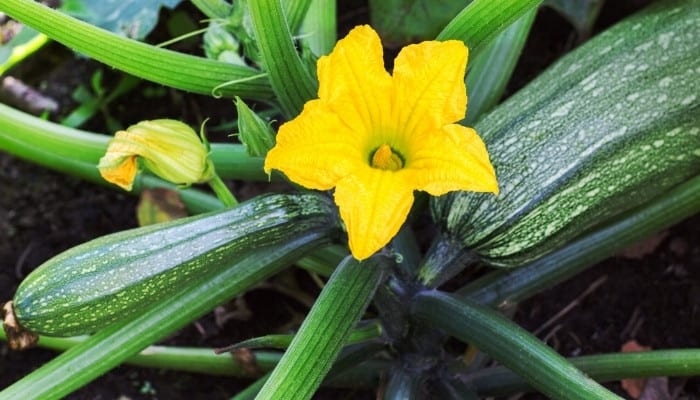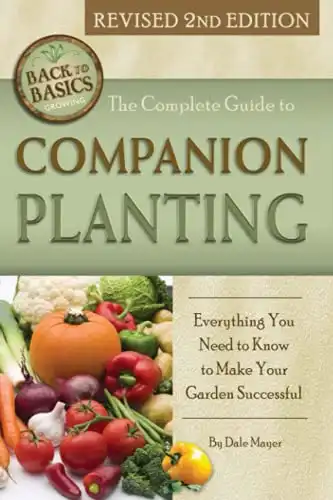Zucchini is frequently ranked as one of the top plants for gardeners to grow because of its abundant yield of fruits.
Jokes abound of home gardeners stuffing their neighbor’s mailbox with excess zucchini or leaving bags of green fruit on front porches during the night in an attempt to rid themselves of an overly abundant harvest.
However, if you want to enjoy zucchini in your garden, it is important to know and plan for its growing season.
How long do zucchini plants live? As they are annual plants, zucchini plants will only live for one growing season, between 90 and 150 days depending on your location, growing conditions, and variety of zucchini. While they will produce abundantly during that time, as soon as the first frost occurs, zucchini plants will die.
While zucchini plants will not come back year after year, you can help extend their growing season with a few easy tricks that we list here.
Zucchini Plant Stages
Zucchini plants will grow quickly from seed, so many areas have enough time to have several planting phases to produce the most fruit in a given season.
As long as you have enough space, you can continue growing and harvesting this hearty food for many months.
Zucchini Plant Life Cycle From Seed to Frost
Depending on the temperature of the soil, zucchini seeds can take anywhere from seven to 10 days to germinate.
Therefore, if you live in an area with a short growing season, you can start the seeds indoors and transplant them outside once the frost is gone to get a jump start on the season.
The seedling will sprout and emerge out of the soil with two distinct leaves, then grow rapidly by spreading out from the base of the plant.
Plant Development
Depending on the variety you choose, these plants can be 2 feet high and between 2 and 3 feet wide.
After six weeks of growing, zucchini plants will develop male flowers first, then female flowers. They are a bright yellow color and look similar to flowers you see from pumpkin plants.
These flowers attract bees to help the pollination process from male to female flowers so the plant can begin producing fruit.
If you are growing indoors or do not have many bees, you can pollinate the plants yourself with a small paintbrush.
It does not take long for zucchini to grow once pollination is complete. Once the female flowers close, you should notice fruit beginning to grow at the base of the plant within days.
Overall, it will only take a week or so for the zucchini to reach full size, perfect for picking.
End of Life
If you live in an area where the growing season is short or you have frost in autumn, your zucchini plant’s life cycle may be cut short.
Typically, a zucchini plant will continue to produce fruit until all the pollinated flowers have given fruit or the plant has exposure to frost.
Overall, from seed to frost, your zucchini plant should live approximately 120 days or longer.
When Are Zucchini Plants Done?
Typically, your zucchini plants will finish producing fruit for the season when your climate has started receiving frost. However, once temperatures dip and the soil becomes colder, this plant stops producing.
If you live in an area with an extended growing season, a zucchini plant may continue growing and producing new flowers for pollination for up to six months.
After that, check the main stem if you do not have any fresh flowers and there is no new growth.
A plant that will no longer produce for the season will have a softer center, or it may begin to rot. This decline is an indication that your plant is done for the year.
Zucchini Temperature Range
A zucchini plant enjoys warm temperatures and will not survive well in cooler climates.
The optimal temperature range to grow zucchini will fall between 55 and 65 degrees Fahrenheit for the evenings and 75 to 85℉ during the daytime.
Common Causes of Early Death of Zucchini Plants
Zucchini plants may die off early for several reasons. This plant may not survive as long as you would like due to inadequate pollination, lack of sunlight, drought, disease, and insect infestations.
Poor pollination can cause blossom rot. When the female flowers do not receive proper pollination, they begin to rot, causing the fruit to follow suit.
Vine borers are insects that can create yellow, wilting leaves on your plant, keeping them from producing the energy needed to bear fruit.
If the soil lacks nutrients or does not receive enough water, you may have a zucchini plant that dies off earlier than you expect.
What Do You Do With Zucchini Plants at the End of the Season?
Once your zucchini plant is no longer producing, you will need to remove it from the soil.
You can easily compost the plant to help create more nutrients for your garden beds later, but if the plant shows any signs of disease or insect activity, do not compost it. Instead, throw it away with your garbage.
Another option you can try is to dry out the leaves and vines, then burn them to ash. This ash is a terrific natural pesticide for your soil.
You should monitor the pH level with a soil sensor, like this 3-in-1 monitor that also checks moisture and light levels, after incorporating ash into the ground before your next growing season, though.
Tips for Getting the Most Fruit From Zucchini Plants
If you want to get the most fruit from your zucchini plant as possible, there are some easy things you can do.
Ensure that the soil has enough nitrogen and that you use organic, nitrogen-rich fertilizers.
However, they require plenty of water, so if your climate is not receiving enough natural rain, be sure to water your zucchini plants often (don’t overwater though!).
You can help pollinate the female flowers as they bloom to give your plant a better chance of producing more fruit.
Your zucchini plant should also have enough space to grow, so be sure you do not plant them too close together in the spring.
Another way to produce as much fruit as possible is to plant seeds in phases.
In areas with a longer growing season, you can plant multiple stages of zucchini plants to help produce fruit throughout the year before the frost comes.
Even if your first few plants are not growing and producing any longer, the second or third-phase plants will be ripe for picking.
Related Questions:
How Long Does a Zucchini Plant Keep Producing?
In a healthy environment, a zucchini plant can continuously produce fruit for up to 150 days. Typically, each plant will give you anywhere from 3-9 pounds of fruit for your family and friends to enjoy.
Poor growing conditions, such as depleted soil or cold weather, will diminish productivity.
What Do You Plant With Zucchini To Keep Bugs Away?
There are several items you can plant as a companion to zucchinis that will help keep bugs away. They include marigolds, radishes, mint, bee balm, tansy, and catnip.
In addition to helping with bugs, many companion plants also provide beautiful flowers and edibles, so it’s a win-win situation.
To learn more about companion planting, I highly recommend The Complete Guide to Companion Planting.
It’s chock full of helpful information and tips for a wide variety of crops. Learn to work in tandem with nature instead of fighting the same problems year after year.
Conclusion
Being familiar with the zucchini life cycle will ensure that you are getting the most out of your plant.
Whether you are overwhelmed with zucchini or you want to enjoy the productivity a little longer, you should now be able to plan ahead and know that your zucchini should live around 120 days.
However, if you are on top of your gardening practices and the weather is favorable, you may be able to extend that a little longer.


